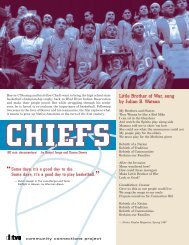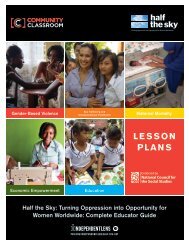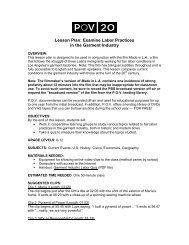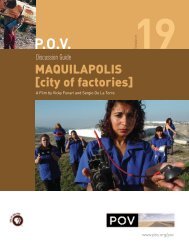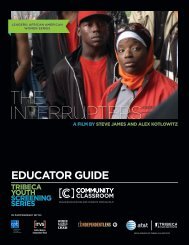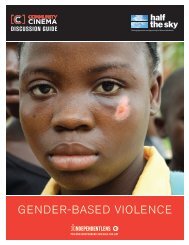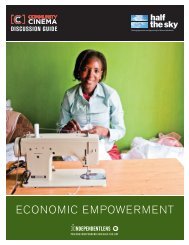Gender-Based Violence: Challenging Impunity - ITVS
Gender-Based Violence: Challenging Impunity - ITVS
Gender-Based Violence: Challenging Impunity - ITVS
Create successful ePaper yourself
Turn your PDF publications into a flip-book with our unique Google optimized e-Paper software.
07<br />
HALF THE SKY<br />
<strong>Gender</strong>-<strong>Based</strong> <strong>Violence</strong>: <strong>Challenging</strong> <strong>Impunity</strong><br />
LESSON PLAN PROCEDURES<br />
Prescreening Activity<br />
Time: 30 minutes<br />
You will need: Student Handout A: Sierra Leone in Context, whiteboard/blackboard, dryerase<br />
markers/chalk, kraft paper, washable markers, medium-sized Post-it notes, a wall map<br />
of the world with country names (free printable maps are available here: www.amaps.com/<br />
mapstoprint/WORLDDOWNLOAD.htm)<br />
Goal: Students will consider the benefits and consequences of taking a stand against an<br />
injustice, and how these factors might affect their own choices. They will learn the definition<br />
of the word impunity and the meaning of the phrase a culture of impunity and discuss the<br />
contributing factors that allow a culture of impunity to develop. In preparation for viewing<br />
the <strong>Gender</strong>-<strong>Based</strong> <strong>Violence</strong> in Sierra Leone film module, students will identify the location<br />
of Sierra Leone on a map and understand the social and political context for the events<br />
depicted in the film.<br />
Part 1: To Speak Out or not to Speak Out<br />
• Divide the class into groups of three to five students and provide each group with a large<br />
sheet of kraft paper, markers, and Post-it notes.<br />
• Give the students the following instructions:<br />
--<br />
Think of a time when you (or someone you know) successfully spoke out in order to right a<br />
wrong or to protect yourself or someone else.<br />
--<br />
Select a Post-it note (one for each student in the group) and write down all of the words you<br />
can think of to describe how you felt about yourself or the other person who took a stand.<br />
--<br />
Discuss your responses as a group, then share your words with the class.<br />
• Have each group hang their kraft paper on the wall and draw a horizontal line across the<br />
middle and mark points along the line numbered one to five as follows:<br />
| | | | |<br />
1 2 3 4 5<br />
• Tell the students that this graph represents the likelihood that a person would speak out in a<br />
given situation (1=least likely; 5=most likely). In this first scenario, they — or the person they<br />
knew — spoke out, so have the students place all of their Post-its on number five.<br />
• Following the pattern of the first question, ask students in each group to write the letter<br />
corresponding to each of the following scenarios and their responses on a Post-it note and<br />
place the completed Post-it on the area of the graph that indicates how likely they would be<br />
to speak out.<br />
--<br />
Imagine that you spoke out about an injustice but nothing was done and the injustice was<br />
not corrected. Write on your Post-it note all of the words that you can think of to describe<br />
how you might feel. Place your Post-it on the graph in the area that indicates how likely<br />
you would be to speak out again.<br />
--




